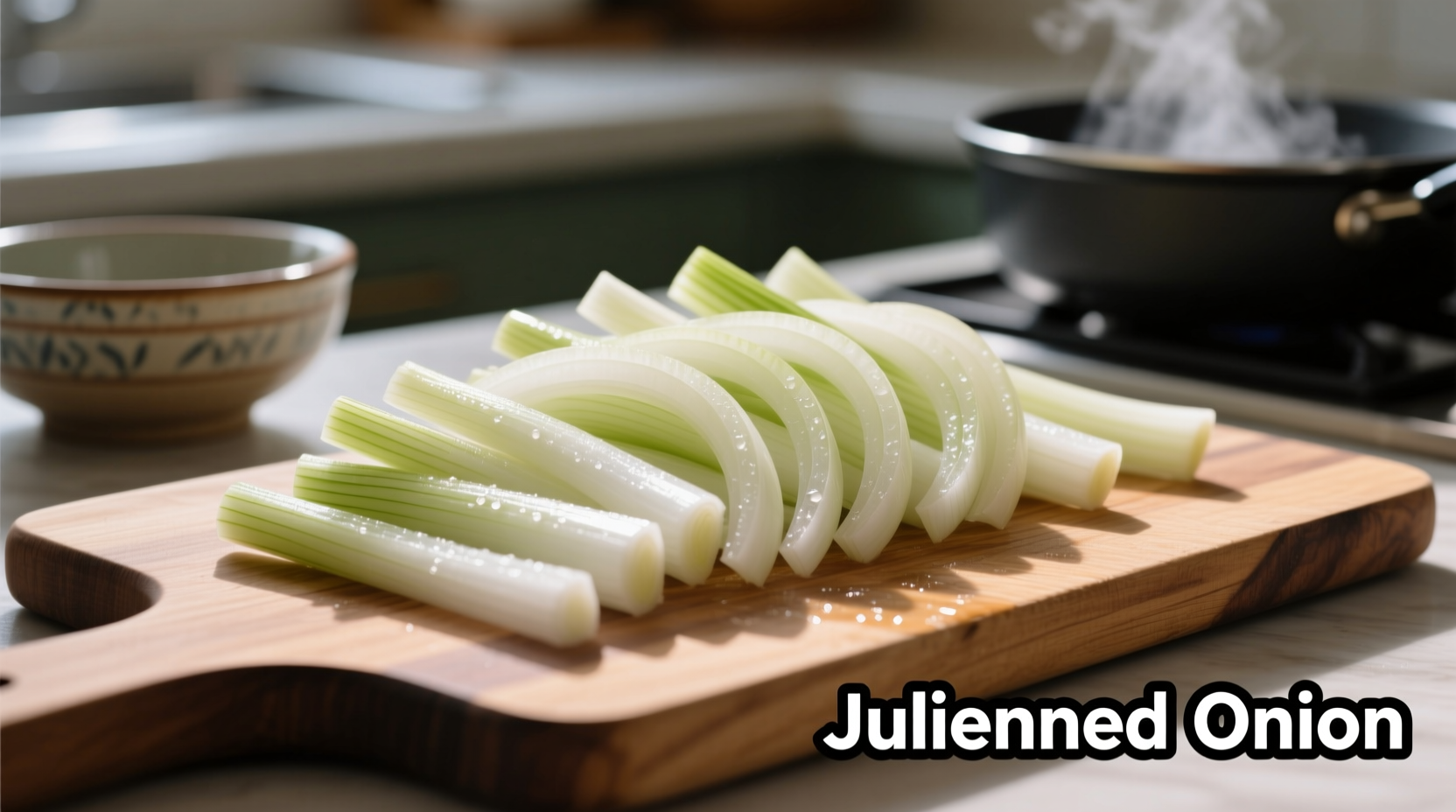Mastering the art of julienning onions transforms your cooking from amateur to professional. This precise cutting technique creates uniform strips that cook evenly, absorb flavors beautifully, and add elegant presentation to your dishes. Whether you're preparing Asian stir-fries, French salads, or modern fusion cuisine, properly julienned onions elevate both visual appeal and taste profile.
Why Julienne Onions Instead of Other Cuts?
The julienne cut serves specific culinary purposes that distinguish it from other onion preparations. Unlike diced onions that disappear into sauces or thick slices that dominate a dish, julienned onions maintain their identity while integrating seamlessly with other ingredients. This cut provides maximum surface area exposure for caramelization while preserving enough structure to remain recognizable after cooking.
| Cut Type | Dimensions | Best For | Cooking Time |
|---|---|---|---|
| Julienne | 1/8" × 1/8" × 2" | Stir-fries, garnishes, salads | 3-5 minutes |
| Dice | 1/4" cubes | Sauces, soups, salsas | 5-8 minutes |
| Wedge | Quartered | Grilling, roasting | 15-20 minutes |
| Thin Slice | 1/16" rounds | Ceviche, sandwiches | Raw applications |
Step-by-Step: Perfect Onion Julienning Technique
Follow these professional steps to achieve restaurant-quality results at home. The key to successful onion julienning lies in proper preparation and consistent knife work.
Preparation Essentials
Start with firm, dry onions—yellow onions work best for most applications due to their balanced sweetness and structure. Chill onions for 30 minutes before cutting to reduce tearing. Use a sharp 8-inch chef's knife and a stable cutting board. Professional kitchens follow FDA food safety guidelines that recommend changing cutting boards between different food types to prevent cross-contamination.
Cutting Process
- Peel and trim both ends of the onion
- Cut vertically in half through the root end
- Place flat side down for stability
- Make vertical slices 1/8 inch apart toward, but not through, the root end
- Rotate 90 degrees and slice horizontally with the same spacing
- Finally, slice vertically to create uniform matchsticks

When to Use Julienned Onions: Context Boundaries
Understanding when not to use julienned onions is as important as knowing how to cut them. This technique shines in applications where visual presentation matters and quick cooking times are essential. Asian cuisine traditions dating back to the 14th century developed this cut specifically for stir-fry techniques that require ingredients to cook rapidly at high heat.
Avoid julienned onions in dishes requiring long simmering times, as they'll lose their shape and become mushy. They're also less suitable for applications where complete flavor integration is desired, such as in rich sauces or soups where diced onions would better distribute their flavor throughout the liquid.
Troubleshooting Common Problems
Even experienced home cooks encounter challenges with onion julienning. The most frequent issue—uneven strips—usually stems from inconsistent spacing during the initial vertical cuts. Maintain steady pressure and use the knuckle guide method where your non-knife hand's knuckles rest against the blade for consistent spacing.
To minimize tearing while cutting onions, work near running water or chill onions thoroughly before preparation. Professional chefs often recommend using a carbon steel knife for onion work, as the chemical reaction between the steel and onion compounds reduces tear-inducing vapors.
Professional Chef Tips for Perfect Results
Seasoned chefs employ several advanced techniques to perfect their onion julienning. First, maintain the root end intact until the final cut—this provides structural stability during the slicing process. Second, practice your knife grip: hold the blade's handle with three fingers while using your index finger and thumb to control the blade near the bolster.
For time efficiency in meal preparation, julienne multiple onions at once and store them properly. The National Onion Association recommends storing cut onions in airtight containers in the refrigerator for up to 5 days. Never store cut onions in metal containers, as this accelerates spoilage through chemical reactions.
Applications Across Global Cuisines
Julienned onions feature prominently in culinary traditions worldwide. In French cuisine, they form the base of julienne soup and garnish classic dishes like salade lyonnaise. Asian cooking relies on this cut for stir-fries and spring rolls, while Middle Eastern cuisine uses it in salads and stuffing mixtures. The uniform shape ensures consistent cooking across diverse culinary applications.











 浙公网安备
33010002000092号
浙公网安备
33010002000092号 浙B2-20120091-4
浙B2-20120091-4